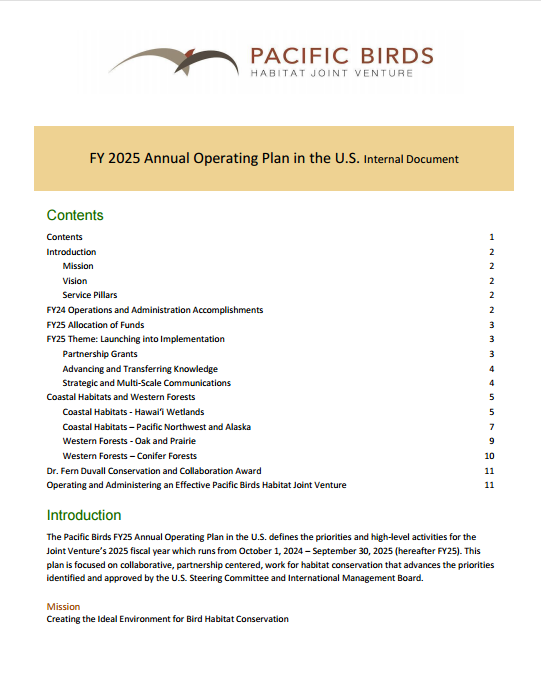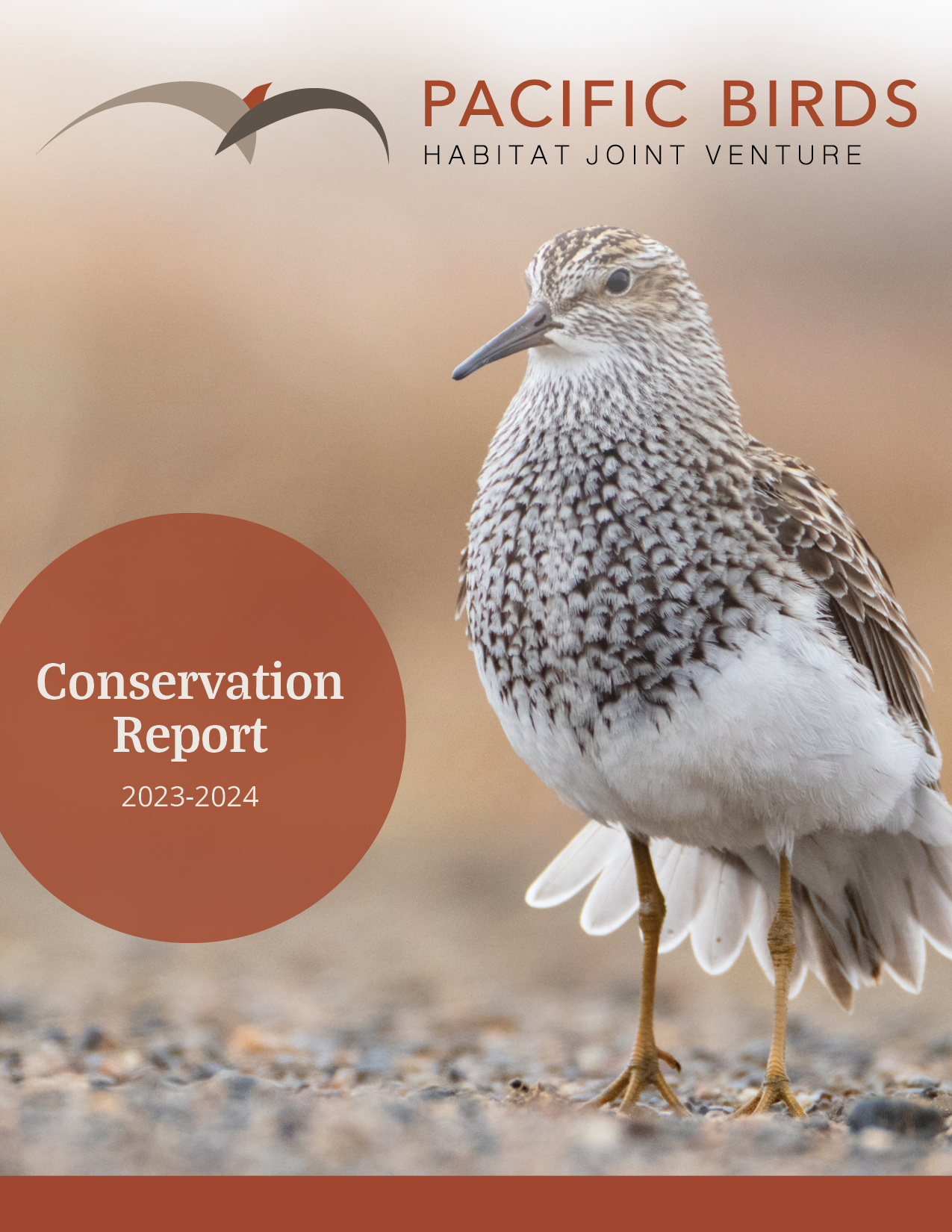Vision By working together in the Pacific Region, we ensure wild birds thrive in abundant and diverse habitats that are safeguarded for future generations.
Mission Creating the Ideal Environment for Bird Habitat Conservation
Pacific Birds' Service Pillars
To catalyze conservation, Pacific Birds staff advance the mission and vision of the Joint Venture by supporting partners through our service pillars. The service pillars represent the niche of the Joint Venture as a broad, non-regulatory, public-private-Tribal partnership with a focus on collaboratively advancing conservation of habitats that birds, other wildlife, and people rely on.
Accelerate and Deliver Conservation
- Protect, restore, and enhance habitats to support birds and people.
- Mainstream conservation actions and activities that benefit birds, habitats, and people.
- Advance funding opportunities that support conservation priorities.
Build Capacity
- Grow capacity for partnerships to advance bird habitat conservation.
- Increase partner capacity to find, secure, and leverage funding.
Promote Collaboration
- Identify and collaborate to advance the priorities and meet the goals identified by the Pacific Birds Partnership.
- Foster and sustain diverse partnerships.
Advance Knowledge and Planning
- Initiate and facilitate partner-driven conservation planning.
- Support transfer of knowledge and applied science to practitioners
- Connect local planning to regional, national, and international objectives and strategies.
Inform and Inspire
- Inspire action for birds
- Provide partners with opportunities, tools, and resources.
- Communicate collective conservation impact.
The benefits of the Pacific Birds Habitat Joint Venture partnership include:
- increased resources
- collaborative solutions
- better communication
- increased public support
- support for landscape-scale conservation action
Indigenous Acknowledgements and Commitments
Pacific Birds Habitat Joint Venture acknowledges that the lands on which we work are the traditional lands of many different Indigenous nations. Acknowledging these lands, and the signed treaties where applicable, reminds us that our places of work, where we live and where we gather, are on the traditional lands of more than 350 Tribes, First Nations, and Indigenous Peoples2, people who have resided here since time immemorial and still do. It is also a recognition that all of us are accountable to these relationships.
The work of Pacific Birds and partners involves the conservation, protection, and enhancement of wildlife and habitat that directly impacts Indigenous communities. We acknowledge the need for meaningful partnerships with Indigenous communities throughout the implementation of this work. Pacific Birds Habitat Joint Venture names the following actions, and asks others to join us, in support of stewarding a more inclusive and equitable future:
- Educate ourselves to better support Tribes and Indigenous Peoples.
- Support Indigenous-led and informed land and water protection, restoration, and stewardship.
- Elevate Indigenous Knowledge3 and Science in conservation.
1 Tribes are sovereign nations with the authority to govern themselves. The source of their authority to govern is ‘inherent,’ meaning that it comes from tribes being self-governing long before explorers and settlers came to the New World. Worcester v. Georgia (1832).
2 "Tribal Nation" or "Tribe" means an Indian or Alaska Native tribe, band, nation, pueblo, village, or community that the Secretary of the Interior acknowledges as a Federally recognized Tribe pursuant to the Federally Recognized Indian Tribe List Act of 1994, 25 U.S.C. § 5130. In the US, "Indigenous Peoples" refers to Native Americans, Alaska Natives, Native Hawaiians, Pacific Islanders, and Indigenous Peoples whose ancestors have occupied what is now known as the United States since time immemorial, including members of Tribal Nations (White House Executive Order). In Canada, “Indigenous Peoples" is a collective name for the original peoples of North America and their descendants, including First Nations, Inuit and Métis.
3 This guidance uses the phrase “Indigenous Knowledge” but recognizes that a variety of terms, including Traditional Ecological Knowledge, Traditional Knowledge, Indigenous Traditional Knowledge, Native Science, and related formulations, which are preferred by different Tribes and Indigenous Peoples. Those terms are used when referencing specific situations in which the relevant Tribes, Indigenous Peoples, or Federal decisionmaker has selected a different term. From Guidance for Federal Departments and Agencies on Indigenous Knowledge.
Annual Operating Plan
The Pacific Birds FY25 Annual Operating Plan in the U.S. defines the priorities, high-level activities, and spending plan for the Joint Venture’s 2025 fiscal year which runs from October 1, 2024 – September 30, 2025.
This plan is focused on achieving our mission as an inclusive, collaborative, partnership centered around the delivery of bird habitat conservation by advancing the priorities identified and approved by the US Steering Committee and International Management Board.
Conservation Reports
Our Partnership
Pacific Birds is for everyone.
Our partnership includes government agencies, non-government organizations, Tribes, First Nations, private landowners, conservation groups, businesses and individuals. We believe that all partners add value and we help ensure they are not working alone.
Pacific Birds believes that conservation succeeds when partners work together to achieve common goals.
We bring people together who are doing important things for birds. From our three decades as a facilitator and convener, we know that collaboration yields the best results for strategic planning, funding, project delivery, and communications.
Pacific Birds reports conservation successes.
Habitat Joint Ventures across North America showcase projects to decision-makers, funders and the interested public. We report the acres of bird habitats conserved to the U.S. Fish and Wildlife Service and Congress on an annual basis.
We want your conservation projects to succeed.
Our staff works for the partnership. We communicate the information that partners need in their work, and we plan at the landscape level to ensure that migratory birds have the habitats they need across flyways. We support organizations and we promote collaboration. We showcase partner projects, knowing that public support is key to the work ahead.
Pacific Birds informs local habitat work, with the flyways in mind.
We help partners connect their on-the-ground projects with the conservation goals of the major bird initiatives. This helps partners secure funding, and it helps birds when their habitat needs are considered across their life-cycles.
Our partnership thrives on engagement and community
Mallards - Michele Dorsey Walfred @ Creative Commons


